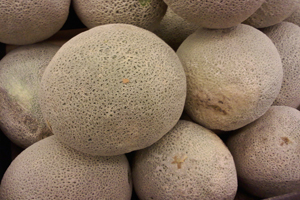Avoiding Listeria: When in Doubt, Throw it Out

While the bacteria is located on the outside of the cantaloupe, the edible part of the fruit is easily contaminated.
Recently, an outbreak of listeria has captured the media spotlight. According to the Centers for Disease Control and Prevention, illnesses associated with the outbreak were first reported on July 31. Since then, 13 deaths have been linked to the outbreak, including two in Texas, while 72 others have reported illnesses due to the bacteria.
An investigation by local, state and federal public health officials have identified the source of the outbreak as whole cantaloupes, grown at Jensen Farms in Granada, Colo. The Federal Drug Administration said the company announced a voluntary recall on Sept. 14.
According to Todd Bell, M.D., serious listeria infections are uncommon, but are more likely in those considered high-risk. People in the high-risk category include newborns, pregnant women, older adults and those with weakened immune systems. Bell said outside of that group, people could be exposed to the bacteria and never show any signs or symptoms.
Listeria symptoms include:
- Fever
- Muscle aches
- Neck stiffness
- Confusion
- Nausea
- Diarrhea
- Loss of balance
One problem with this outbreak is that even though the bacterium is located on the outside of the cantaloupe, it’s easy to contaminate the part we eat.
“When someone is cutting the cantaloupe then they may have a difficult time being able to clean the peel and may contaminate the part of the cantaloupe you eat,” Bell said.
Bell stressed that if you have recently eaten cantaloupe and start to exhibit any of the symptoms, it is important that you make an appointment to see your physician. Illnesses associated with the bacteria are generally treated with antibiotics.
The CDC said other cantaloupes not from Jensen Farms are safe to eat. However, if you are uncertain about where your cantaloupe is from, they urge you to follow the “when in doubt, throw it out,” rule.
Related Stories
Celebrating Veterans: TTUHSC’s General Martin Clay’s Legacy of Service and Leadership
From his initial enlistment in the Army National Guard 36 years ago to his leadership in military and civilian health care management roles, Major General Martin Clay’s career has been shaped by adaptability, mission focus and service to others.
Texas Tech University Health Sciences Center School of Nursing Named Best Accelerated Bachelor of Science in Nursing Program in Texas
The TTUHSC School of Nursing Accelerated Bachelor of Science in Nursing (BSN) program has been ranked the No. 1 accelerated nursing program in Texas by RegisteredNursing.org.
TTUHSC Names New Regional Dean for the School of Nursing
Louise Rice, DNP, RN, has been named regional dean of the TTUHSC School of Nursing on the Amarillo campus.
Recent Stories
TTUHSC Cancer Researcher Honored by National Academy of Inventors
C. Patrick Reynolds, M.D., Ph.D., director of the School of Medicine Pediatric Cancer Research Center at TTUHSC, has dedicated his life as a researcher to developing treatments for childhood cancers.
TTUHSC School of Nursing Celebrates 10 Years of the Veteran to BSN Program
The TTUHSC School of Nursing recognized the 10-year anniversary of the Veteran to Bachelor of Science in Nursing (VBSN) program during the fall 2025 commencement ceremonies held Dec. 13 in Lubbock, Texas.
TTUHSC Dean to be Inducted into the National Academies of Practice as Distinguished Fellow
Gerard E. Carrino, Ph.D., MPH, dean of the TTUHSC Julia Jones Matthews School of Population and Public Health, will be inducted into the National Academies of Practice (NAP) as a Distinguished Fellow of the Public Health Academy.
